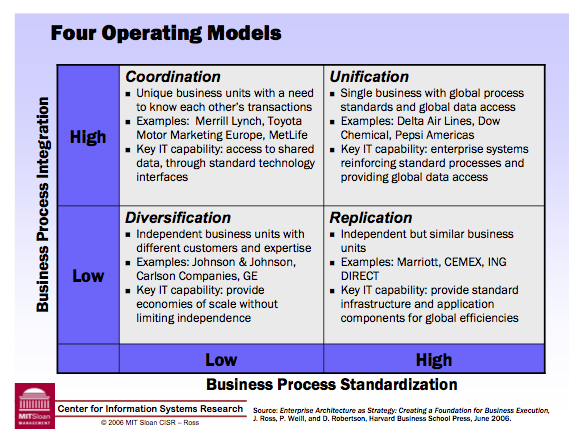Thinking Globally - Where Should a CIO Begin?
post by Chris Curran on October 23, 2009A few weeks ago, I participated in a workshop with a global financial services CIO and a few of his leadership team to discuss what the coming 3-5 years would mean for the IT function and its role in the business.
The most important driver of this kind of conversation has to be where the business is headed. To serve as a proxy for this, we spent a good deal of time talking about questions facing the business:
- Geographic expansion?
- Product range diversification?
- Distribution channel expansion?
- New target customer segments?
- M&A activity?
These kinds of discussions often tailspin into how to organize the IT function, with the concept of a “federated” IT model taking center stage.
However, my advice is to think about the business operating model first, and let that drive the IT discussions. The framework we used for this conversation was one developed by Jeanne Ross at MIT’s Center for Information Systems Research. Along with her colleagues Peter Weill and David Robertson in their excellent book Enterprise Architecture as Strategy, she describes a business operating model as:
The desired level of business process integration and business process standardization for delivering goods and services to customers.
By looking at each business (or business unit) along these two dimensions, with a good idea of the answers to the five questions above, you can start to develop characteristics of both the business design and technology systems for each of the four resulting quadrants. MIT’s version looks like this:

Business Operating Model - Ross, Weill, Robertson (MIT)
Does Your Technology Match Your Business Model?
When looking at a chart like this, the obvious question is “where are we?” When answering this, it’s important to first look at where the business is today. For example, a wireless telecommunication company I spent many years with was very entrepreneurial and based its business on creating scores of local offices across North America. To do this, they created a cookie cutter business and technology model that could be applied in any market - high business process standardization but low business process integration, or a “Replication” operating model. Their IT organization was basically a centralized IT factory that developed and maintained the core cookie cutters and support systems for the local businesses to operate.
In the case of the financial services organization, things are a bit different. Because they have been growing through acquisition of late, they have a collection of businesses that do the same things, but in much different ways - low business process standardization but a high(er) level of process coordination, or a “Coordination” operating model.
Coordination is where they are today, but not where they want to be. For the vast majority of their business, they hope to move to the Unification model to bring their core products into a single set of business processes. Even across Europe, the UK and North America, their products and processes share much more than they deviate.
Addressing the Federated IT Model
With an idea of the target operating model in mind, the target IT operating model is next. Here are some thoughts on how the two relate.
| Operating Model | IT Strategy, Planning & Management | Application Development & Maintenance | Infrastructure |
|---|---|---|---|
| Diversification |
Distributed, with some basic infrastructure and vendor planning centrally |
Distributed |
Centralized network & office infrastructure utility |
| Replication |
Centralized infrastructure planning; Shared planning for core app suite |
Core Business Apps - centralized; Local apps and innvoations - distributed |
Provisioning of “replicated” infrastructure is centralized |
| Coordination |
Centralized infrastructure, data and integration planning & management; Business specific planning is distributed |
Centralized for Enterprise apps, data and middleware systems; Enterprise apps |
Centralized infrastructure provisioning for shared apps, data and middleware |
| Unification |
Centralized |
Centralized |
Centralized |
Two final thoughts. First, this kind of thinking can be applied to companies with several distinct business units; a global footprint is not required. Second, this is a much more complicated topic than is outlined here - especially when culture and language enters the discussion. However, I think its an important starting point to start with the business direction, think about the resulting business operating models and only then, start working with the resulting target IT operating designs. Love to hear your thoughts.




Pingback: Tweets that mention Thinking Globally – Where Should a CIO Begin? — CIO Dashboard -- Topsy.com()